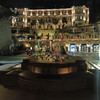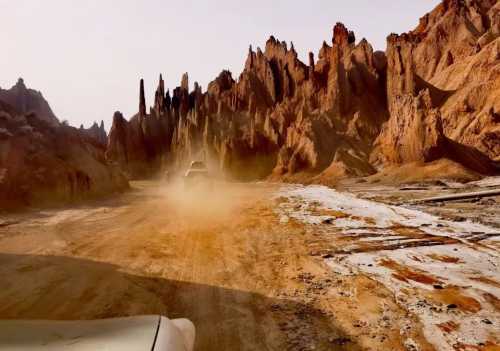Popular Trip Moments
Stunning Yili🪻 | Xinjiang Cultural Exhibition at Your Doorstep | Western Frontier Sanctuary: The A'ai Cave | Xinjiang | 20 Photos Taken by a City Photographer on His First Trip to Xinjiang | Mysterious Grand Canyon of the Tianshan Mountains: A Scarlet Wonder | Kuche Grand Naan: Millennia of Wheat Aroma on the Silk Road | Aksu Self-Driving Guide! 3 Days Racing Through the Secret South Xinjiang | Xinjiang Naan: Ancient Aroma Wafting Through the Silk Road | Kuche Grand Naan City: A Non-Genuine Cultural Journey on the Tip of the Tongue | Classic Xinjiang Cross-Country Route (Northern Xinjiang + Southern Xinjiang) | Ili + Duku Highway Full Route Self-Driving Guide | Southern Xinjiang Silk Road Intangible Cultural Heritage Artisan Journey|“Living Intangible Heritage” | The earth’s burning flames traverse a secret realm across hundreds of millions of years | Real Name Praise for Kuqa Hotel! | Solo female trip to Southern Xinjiang for 7 days and 6 nights, averaging 3k per person, unlocking hidden desert poplar experiences | Which Heavenly Hotel Is This? | 10-Day Itinerary for Northern and Southern Xinjiang | Colorful Doors in the Ancient City of Kashgar | Secret Snow Mountain Hiking Guide | Golden Autumn Adventure! Explore the Secrets of Southern Xinjiang | First Encounter with Poplar Trees | Comfortable 8-Day Tour Guide in Southern Xinjiang | Xinjiang 8-Day Travel Guide | Mystical Loulan: Golden Autumn in Southern Xinjiang! | 【Ultimate Challenge·Crossing the Tianshan】In-Depth Duku Highway Guide! | Tianshan Mysterious Grand Canyon: A Solo Adventure Like No Other! 🌄✨ | Travel always comes with a little regret | Journey through the Western Regions for a Thousand Years! Kuche Palace Verifies the Historical Code of "Twelve Generations of Princes" | A guide to visiting the Kyzilya Grand Canyon in Xinjiang, China, perfect for adventurous people looking to check in and take photos📸 | Never Do This at the Bottom of the Canyon! Or Face Uyghur Auntie's Rap Warning | OMG! This pink desert in Aksu looks exactly like spilled strawberry milkshake!
Recommended Attractions at Popular Destinations
Popular Attractions in Bangkok | Popular Attractions in Kuala Lumpur | Popular Attractions in Dubai | Popular Attractions in Chefchaouene | Popular Attractions in Kyoto | Popular Attractions in Los Angeles | Popular Attractions in Bali | Popular Attractions in Shanghai | Popular Attractions in Iguazu National Park(Argentina) | Popular Attractions in New York | Popular Attractions in Paris | Popular Attractions in Walt Disney World Resort | Popular Attractions in Melbourne | Popular Attractions in London | Popular Attractions in Singapore | Popular Attractions in Beijing | Popular Attractions in Las Vegas | Popular Attractions in Rome | Popular Attractions in Zanzibar Island | Popular Attractions in Sydney | Popular Attractions in West Lake | Popular Attractions in Osaka | Popular Attractions in Tokyo | Popular Attractions in Phuket | Popular Attractions in Barcelona | Popular Attractions in Madrid | Popular Attractions in Chengdu | Popular Attractions in Florence | Popular Attractions in Istanbul | Popular Attractions in Jungfrau Region
Popular Attractions
Taohuayu | Qiantang River | Houshi Dock | Doumu Palace | Bai Causeway | Hupao Park | House of the Xue Family | Cuihua Mountain·Qinling Zhongnanshan Unesco Global Geopark | Xian Banpo Museum | Big Wild Goose Pagoda | Songzilaifeng Bridge | Shipi Lane | Huajue Lane, the Great Mosque | Shaanxi History Museum | Qinglong Temple | Manfeilong Pagoda | Xishuangbanna Dai Garden | Lingao Jiao | Cai Yuanpei Former Residence | Zhou Enlai's Ancestral Residence | East Rosebud Trailhead | Laleh park | Escadrille parc des.combes | J Harley Smith Park | Red Minaret Mosque | Plaza Álvaro Barros | Naturismo Sul Piave | Spiral Garden | Nicholson Park | Library Of Franciade
Popular Restaurants in Kuqa
LAO ER SHA NANG KENG ROU | 库车饭店 | 亚力馕坑肉(库车总店) | 库车朝昱万华国际酒店·朝昱餐厅 | 库车饭店-99西餐厅 | 亚克西姆新疆菜(库车店) | 库车阿力木夹馅面食馆 | 北木南烤肉和酒(库车店) | 库车一陽咖啡古堡餐厅(博斯坦路店) | 溢香阁大盘鸡(健康路店) | 德克士(库车时运店) | 阿尔茶抓饭店(原甜穆奇鸽子汤店) | 好日子川菜馆 | 库车天缘国际酒店良缘西餐厅 | 心甜咖啡 | 南湖夜市 | 胖子抓饭(步行街店) | 八楼猪蹄(分店) | 阿咔丝亚(春熙里·湖墅店) | 再帕尔美食(幸福城店) | 金刚尔沙馕坑烤肉王(龙泽苑店) | 喀尔博瓦爷纯手工冰淇淋店(库车店) | 宝库美食馆 | 古莱莱草湖果木炭馕坑肉 | 库车金色阳光宾馆·自助餐厅 | YAO JI QIAO JIANG NA CAN TING | 酸汤馄饨·黄面烤肉(库车饭店) | 新雅典西饼屋(库车总店) | 爱的礼物(天五店) | Zhangdashiyazhaozhaotese Hot Pot (kuche)
Popular Ranked Lists
Popular Premium Hotels in Shirdi | Popular Best Things to Do in Duyun | Popular Premium Hotels in Northumberland | Top 50 Must-Visit Restaurants in Ho Chi Minh City | Top 50 Best Things to Do in Frankfurt | Top 50 Must-Visit Restaurants in Madrid | Popular Premium Hotels in Bedford | Top 50 Must-Visit Restaurants in Koh Samui | Top 50 Must-Visit Restaurants in Chaozhou | Top 50 Luxury Hotels near Sichon | Popular Premium Hotels in Whitianga | Top 50 Must-Visit Restaurants in Nanjing | Popular Best Things to Do in Cebu | Top 50 Must-Visit Restaurants in Jeju | Top 10 Best Things to Do in Incheon | Top 50 Luxury Hotels near Songkhla | Popular Premium Hotels in Thu Dau Mot | Popular Premium Hotels in Arrowtown | Top 50 Must-Visit Restaurants in Dubai | Top 10 Luxury Hotels near Docklands | Popular Premium Hotels in West Yorkshire | Top 10 Best Things to Do in Minsk | Top 10 Luxury Hotels near Thai Binh | Top 50 Luxury Hotels near Nakhon Pathom | Popular Best Things to Do in Mian County | Top 50 Luxury Hotels near Monza | Top 50 Must-Visit Restaurants in Berlin | Top 10 Best Things to Do in Almaty | Top 50 Must-Visit Restaurants in Sanya | Top 50 Must-Visit Restaurants in Langkawi
About
Payment methods
Our partners
Copyright © 2025 Trip.com Travel Singapore Pte. Ltd. All rights reserved
Site Operator: Trip.com Travel Singapore Pte. Ltd.
Site Operator: Trip.com Travel Singapore Pte. Ltd.















